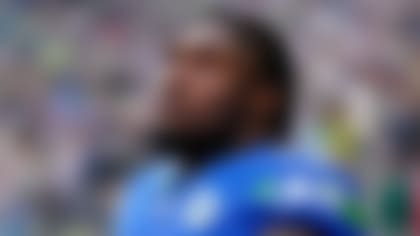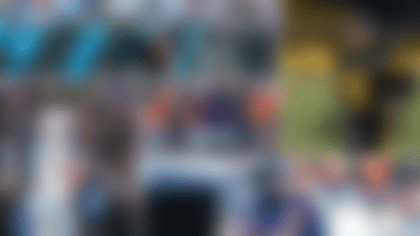The Seattle Seahawks have been considered a legitimate Super Bowl contender all season, but it was a resounding 34-7 win over the New Orleans Saints in Week 13 that prompted many to tout the team as the best in football. The Saints are unquestionably one of the most explosive offenses in the NFL, yet they were unable to muster much against a Seahawks defense that pummeled them at every turn in that highly anticipated "Monday Night Football" showdown one month ago.
While a single-game disaster occurs from time to time, the Seahawks' complete domination in that contest creates questions about whether the Saints have a fighting chance in Saturday's rematch at CenturyLink Field.
After studying the All-22 Coaches Film, I believe the Saints will need to pull a rabbit out of their hat to topple the NFC's bully on the block.
KEYS TO SEATTLE'S WEEK 13 SUCCESS
Seattle coach Pete Carroll has built one of the NFL's elite defenses by stocking up on explosive athletes with speed, quickness and a nasty disposition. Carroll unleashes his players' natural talents by employing a simple scheme that allows them to play fast and chase the ball with reckless abandon. While most defenses attempt to fool or confuse opponents with exotic schemes, the Seahawks bully foes with a game plan that is built on simplicity and physical destruction. Looking at the All-22 Coaches Film of Seattle's blowout win over New Orleans, here are a few objectives that stood out:
1) Routinely pressuring Drew Brees with three- and four-man rushes.
FedEx Air & Ground Players of Year
Drew Brees became the first quarterback in NFL history with three consecutive 5,000-yard seasons. Was it the best performance for a quarterback in 2013?
Every defensive coach raves about the importance of getting to the quarterback with a three- or four-man rush. The ability to create consistent pressure without sending extra rushers allows a defense to drop seven and eight defenders into coverage to blanket the passing game. The Seahawks were able to accomplish this task in the first meeting, with Michael Bennett, Chris Clemons and Cliff Avril creating chaos off the edges. Combining the collective speed, quickness and athleticism of the front line with airtight coverage in the back end, the Seahawks held the Saints to just 188 total yards of offense -- the lowest output in the Drew Brees/Sean Payton era.
COVER 3
The Seahawks are one of the few teams in the NFL using Cover 3 (three deep defenders with four underneath droppers) as a primary coverage in their game plan. The coverage is ideal against the run, thanks to its ability to incorporate an eight-man front, but the Seahawks have used it to effectively take away the deep ball and force quarterbacks to settle for checkdowns and dump-offs.
In the following screengrab, which was taken from Week 13, the Seahawks are in Cover 3, with cornerbacks Richard Sherman and Byron Maxwell defending the deep outside area of the field and safety Earl Thomas patrolling the deep middle. The underneath droppers (strong safety, nickel corner and two inside linebackers) are assigned to various spot drops on the numbers and hashes to create an umbrella around the Saints' passing game:
With the deep defenders taking away the vertical throws and the underneath defenders swarming to the short routes, Brees is unable to find an open receiver when he reaches the top of his drop. Consequently, Avril works free off the edge and bears down on Brees:
Avril knocks the ball loose and right into the hands of Bennett, who returns it 22 yards for a touchdown.
The Saints attempt to run a flood route, with tight end Jimmy Graham executing a corner and running back Pierre Thomas running to the flat, creating a high-low read for Brees. The Seahawks are all over it, with the numbers dropper (Bruce Irvin) flying to Thomas and the hook dropper (Bobby Wagner) settling under Graham:
This forces Brees to make an elevated throw to Graham, providing Irvin with enough time to jar the ball loose before Graham can fully corral it.
In the screengrab below, the Seahawks are in Cover 3 Max (three deep defenders, five underneath droppers) in the red zone. The coverage is designed to create a picket fence along the end zone, forcing the quarterback to settle for a checkdown underneath the coverage:
The Seahawks execute the coverage perfectly by getting to their landmarks and keeping vision on the quarterback:
Brees doesn't have anywhere to go with the football, leading to an incompletion on the play.
COVER 1
The Seahawks have assembled a deep and talented collection of second-level players during the Carroll era. The defensive unit features big, explosive linebackers capable of running with tight ends and running backs down the seam, as well as defensive backs who excel at mauling receivers at the line of scrimmage. This allows Carroll to use a host of man coverages to eliminate the easy throws that create a rhythm for an NFL quarterback. Against the Saints, the Seahawks threw a blanket over the passing attack by mixing in a few variations of Cover 1 throughout the game.
In the following series of screengrabs, the Seahawks are in Cover 1, with Thomas playing the deep middle. The corners are pressing the outside receivers, with safety Kam Chancellor prepared to harass Graham at the line of scrimmage:
Eventually, he settles for a 3-yard gain to fullback Jed Collins in the flat.
Without an open receiver in the progression, Brees is forced to throw the ball away to avoid a sack.
After the snap, though, the Seahawks swarm Graham and his teammates at the line of scrimmage:
Brees attempts to take a shot down the field, but he's hit on the release and the pass falls incomplete.
2) Disrupting timing in the passing game with press coverage outside.
Reviewing the above pictures and videos, the prevailing theme is an aggressive use of bump-and-run technique by the Seahawks' corners. Sherman, Maxwell and Jeremy Lane mauled Saints receivers on the perimeter, disrupting the rhythm of New Orleans' aerial attack. The Seahawks made Saints receivers work hard to get open and eliminated the easy throws Brees relies on to stay on pace.
3) Stymieing Jimmy Graham with Kam Chancellor and Co.
Chancellor frequently met Graham near the line of scrimmage in man coverage, and the safety used his size and strength to muscle the tight end off his route. Additionally, Chancellor crowded Graham down the field and left him little room to maneuver throughout his route.
With a ferocious pass rush preventing Brees from patiently waiting for Graham to eventually work free, the Seahawks were able to hold the NFL's most dangerous tight end to three receptions (though one went for a touchdown).
KEYS FOR NEW ORLEANS IN THE REMATCH
Given the opportunity to play the Seahawks again, I'm sure Sean Payton and his staff will significantly revamp the original game plan and implement a few tactics opponents have used to successfully move the ball against Seattle. Here are three things I would expect to see from the Saints in the rematch:
1) Running the ball from jumbo and power formations.
The Seahawks ranked seventh against the run during the regular season, but opponents enjoyed success down the stretch by pounding the ball out of jumbo and power looks. Although the Seahawks have held opponents to 3.9 yards per carry -- surrendering just six runs of 20-plus yards -- the persistent, power-oriented approach used by the San Francisco 49ers and Arizona Cardinals allowed both teams to control the tempo in their respective wins over Seattle.
Debate: Road rulers this weekend?
The Saints initially attempted to run the ball at the Seahawks from a handful of power sets, but they didn't stay committed to grinding it out when they failed to pick up consistent yards on early downs. While moving away from the ground game is understandable in certain instances, the Saints must focus on attempts -- not yards -- in the rematch. This was part of their approach last Saturday night in Philadelphia, when they totaled 185 rushing yards on 36 attempts.
With Thomas on the shelf, Payton relied on a three-back rotation of Mark Ingram, Khiry Robinson and Darren Sproles to wear down the Eagles' smallish defensive front. Ingram in particular was effective in pounding the ball between the tackles. This enabled Payton to turn to the running game and alleviate pressure on Brees in the pocket. Against the Seahawks, Ingram needs to play a major role as the feature back in the game plan. He must be given 18-plus carries for the Saints to get the game on their own terms.
Here are two of the sets the Saints must incorporate to get Ingram and Co. loose in the rematch ...
Offset I-formation with 22 personnel (2 RB, 2 TE, 1 WR):
Ace-Trey Wing with 13 personnel (1 RB, 3 TE, 1 WR):
2) Making the running backs a focal point in the passing game.
The Seahawks' utilization of Cover 1 and Cover 3 forces quarterbacks to settle for checkdowns. Most quarterbacks refuse to do so, leading to turnovers off forced throws into tight coverage. In the first meeting, Brees tossed 12 of his 38 passes to running backs, connecting with Sproles on seven throws for 32 yards. Now, those numbers aren't impressive, but Brees could enhance the effectiveness of the running backs by getting the ball to Sproles (and Thomas, if he's healthy) quicker in the pass progression. Brees frequently hesitated before finding his outlets in space, allowing the Seahawks to close quickly and eliminate yards after catch.
If Brees can make it a point to "dink and dunk" quicker in the rematch, the barrage of short throws could eventually entice a Seahawks defender to leave his assigned area, resulting in a big play down the field.
3) Taking shots to Kenny Stills and Robert Meachem off double moves.
Harrison: Power Rankings
In the wake of a Wild Card Weekend that truly lived up to its name, Elliot Harrison eyes the playoff field. Who's rising at the right time? **READ**
The Seahawks' top-ranked pass defense suffocates aerial attacks, but a few opponents have been able to generate big plays against the "Legion of Boom." Most of those plays have come from double-move routes on the perimeter against the Seahawks' aggressive corners.
Looking at the All-22 footage from throughout the season, I noticed that smaller receivers (like the Indianapolis Colts' T.Y. Hilton and Minnesota Vikings' Jarius Wright) have been able to escape the clutches of Seattle's corners with crafty moves on the perimeter. Part of their success can be attributed to superb stop-start quickness in routes, which allows them to take advantage of overambitious corners.
For the Saints, the most effective double-move artists are Stills and Meachem. Each guy has shown the ability to accelerate quickly out of breaks, which is critical to executing the maneuver. In the first meeting, Payton unsuccessfully attempted to take shots to Meachem early in the contest against Sherman. Although deep-ball throws are low-percentage propositions, the Saints must take enough vertical shots to keep Seahawks corners from clamping down on the short and intermediate routes. If Brees can put up eight deep-ball shots over the course of the game (an average of two per quarter), he should be able to create more space for his receivers on possession routes.
Follow Bucky Brooks on Twitter @BuckyBrooks.




